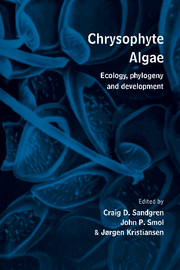Book contents
- Frontmatter
- Contents
- Preface
- List of contributors
- 1 History of chrysophyte research: origin and development of concepts and ideas
- Part I Phylogeny, systematics and evolution
- 2 Evolution of plastid genomes: inferences from discordant molecular phylogenies
- 3 A modern concept of chrysophyte classification
- 4 Current status of chrysophyte ‘splinter groups’: synurophytes, pedinellids, silicoflagellates
- Part II Development, physiology and nutrition
- Part III Ecology, paleoecology and reproduction
- Part IV Contributed original papers
- Index of scientific names
- Subject index
2 - Evolution of plastid genomes: inferences from discordant molecular phylogenies
Published online by Cambridge University Press: 05 March 2012
- Frontmatter
- Contents
- Preface
- List of contributors
- 1 History of chrysophyte research: origin and development of concepts and ideas
- Part I Phylogeny, systematics and evolution
- 2 Evolution of plastid genomes: inferences from discordant molecular phylogenies
- 3 A modern concept of chrysophyte classification
- 4 Current status of chrysophyte ‘splinter groups’: synurophytes, pedinellids, silicoflagellates
- Part II Development, physiology and nutrition
- Part III Ecology, paleoecology and reproduction
- Part IV Contributed original papers
- Index of scientific names
- Subject index
Summary
Introduction
Substantial morphological, biochemical and genetic diversity exists among photosynthetic eukaryotes. Some of the most conspicuous differences involve plastid-based characters. These features, such as the photosynthetic pigment complement, have provided a basis for defining plant and algal taxa. Christensen (1962) classified algae into three divisions according to their pigment composition. In this system, the division chlorophyta includes plants and algae that possess chlorophylls a and b, the Chromophyta are algae that predominantly contain chlorophylls a and c, while the Rhodophyta are defined in part as those algae having primarily chlorophyll a and accessory phycobilin pigments. However, autotrophic eukaryotes evolved in a stepwise manner with the mitochondrial and plastid organelles originating from formerly free-living prokaryotic endosymbionts (Gray & Doolittle 1982). In examining the evolution of these organisms, one must consider the evolution of not only the host, but also its organelles with their prokaryotic ancestors.
By examining cytosolic and nuclear features exclusive of plastid characters, one can infer relationships between extant plants and algae. Such studies have lent support to the validity of the Rhodophyta and Chlorophyta as true phylogenetic assemblages (natural taxa). For example, the complete absence of actual or vestigial flagella in rhodophytes (Gabrielson et al. 1985) and conserved features of karyokinesis and flagellar root structure in chlorophytes (Mattox & Stewart 1984) support the evolutionary cohesiveness of these groups. Furthermore, comparison of nuclearencoded ribosomal RNA (rRNA) supports the model of a monophyletic origin for green and red algae (Perasso et al. 1989; Chapman & Buchheim 1991).
- Type
- Chapter
- Information
- Chrysophyte AlgaeEcology, Phylogeny and Development, pp. 25 - 45Publisher: Cambridge University PressPrint publication year: 1995
- 2
- Cited by

